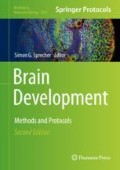Abstract
The dynamic expression pattern analysis provides the primary information of gene function. Differences of the RNA and/or protein location will provide valuable information for gene expression regulation. Generally, in situ hybridization (ISH) and immunohistochemistry (IHC) are two main techniques to visualize the locations of gene transcripts and protein products in situ, respectively. Here we describe the protocol for the whole brain dissection, the in situ hybridization, and the immunostaining of the developing Xenopus brain sections. Additionally, we point out the modification of in situ hybridization for microRNA expression detection.
Access this chapter
Tax calculation will be finalised at checkout
Purchases are for personal use only
References
Harland RM (1991) In situ hybridization: an improved whole-mount method for Xenopus embryos. Methods Cell Biol 36:685–695
Lupo G, Liu Y, Qiu R, Chandraratna RA, Barsacchi G, He RQ, Harris WA (2005) Dorsoventral patterning of the Xenopus eye: a collaboration of Retinoid, Hedgehog and FGF receptor signaling. Development 132:1737–1748
Liu Y, Lupo G, Marchitiello A, Gestri G, He RQ, Banfi S, Barsacchi G (2001) Expression of the Xvax2 gene demarcates presumptive ventral telencephalon and specific visual structures in Xenopus laevis. Mech Dev 100:115–118
Lan L, Liu M, Liu Y, He R (2007) Expression and antibody preparation of POU transcription factor qBrn-1. Protein Pept Lett 14:7–11
Lan L, Liu M, Liu Y, Zhang W, Xue J, Xue Z, He R (2006) Expression of qBrn-1, a new member of the POU gene family, in the early developing nervous system and embryonic kidney. Dev Dyn 235:1107–1114
Saint-Jeannet JP (2017) Whole-mount in situ hybridization of Xenopus embryos. Cold Spring Harbor Protoc 2017:pdb prot097287. https://doi.org/10.1101/pdb.prot097287
Decembrini S, Bressan D, Vignali R, Pitto L, Mariotti S, Rainaldi G, Wang X, Evangelista M, Barsacchi G, Cremisi F (2009) MicroRNAs couple cell fate and developmental timing in retina. Proc Natl Acad Sci U S A 106(50):21179–21184
Liu K, Liu Y, Mo W, Qiu R, Wang X, Wu JY, He R (2011) MiR-124 regulates early neurogenesis in the optic vesicle and forebrain, targeting NeuroD1. Nucleic Acids Res 39:2869–2879
Qiu R, Liu Y, Wu JY, Liu K, Mo W, He R (2009) Misexpression of miR-196a induces eye anomaly in Xenopus laevis. Brain Res Bull 79:26–31
Qiu R, Liu K, Liu Y, Mo W, Flynt AS, Patton JG, Kar A, Wu JY, He R (2009) The role of miR-124a in early development of the Xenopus eye. Mech Dev 126:804–816
Susaki EA, Tainaka K, Perrin D, Yukinaga H, Kuno A, Ueda HR (2015) Advanced CUBIC protocols for whole-brain and whole-body clearing and imaging. Nat Protocols 10(11):1709–1727
Sive HL, Grainger RM, Richard RM (2002) Early development of Xenopus laevis: a laboratory manual. Cold Spring Harbor Laboratory Press, Cold Spring Harbor, NY
Nieuwkoop PD, Faber J (1994) Normal table of Xenopus laevis (Daudin): a systematical and chronological survey of the development from the fertilized egg till the end of metamorphosis. Garland, New York
Kloosterman WP, Wienholds E, de Bruijn E, Kauppinen S, Plasterk RH (2006) In situ detection of miRNAs in animal embryos using LNA modified oligonucleotide probes. Nat Methods 3:27–29
Acknowledgments
We are grateful to Federico Cremisi for sharing the protocol of in situ hybridization with cryosections. This work was supported by the NSFC No.31271387.
Author information
Authors and Affiliations
Corresponding author
Editor information
Editors and Affiliations
Rights and permissions
Copyright information
© 2020 Springer Science+Business Media, LLC, part of Springer Nature
About this protocol
Cite this protocol
Liu, Kl., Wang, Xm., Li, Zl., Liu, Y., He, Rq. (2020). In Situ Hybridization and Immunostaining of Xenopus Brain. In: Sprecher, S. (eds) Brain Development. Methods in Molecular Biology, vol 2047. Humana, New York, NY. https://doi.org/10.1007/978-1-4939-9732-9_20
Download citation
DOI: https://doi.org/10.1007/978-1-4939-9732-9_20
Published:
Publisher Name: Humana, New York, NY
Print ISBN: 978-1-4939-9731-2
Online ISBN: 978-1-4939-9732-9
eBook Packages: Springer Protocols

